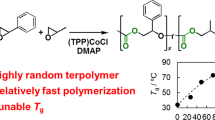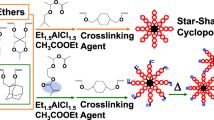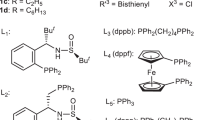Abstract
The synthesis and characterization of organic-inorganic thermoresponsive poly(substituted methylene)s are described. Diazoacetates with oligo(ethylene glycol)-substituted cyclotriphosphazenes were synthesized, and the obtained products were employed as monomers for Pd-initiated polymerization to produce carbon–carbon main chain polymers bearing an oligo(ethylene glycol)-substituted cyclotriphosphazene on every main chain carbon atom. The resulting polymers with densely accumulated oligo(ethylene glycol) units around the polymer main chain showed lower critical solution temperature-type phase separation in an aqueous medium.
This is a preview of subscription content, access via your institution
Access options
Subscribe to this journal
Receive 12 print issues and online access
$259.00 per year
only $21.58 per issue
Buy this article
- Purchase on Springer Link
- Instant access to full article PDF
Prices may be subject to local taxes which are calculated during checkout



Similar content being viewed by others
References
Ihara E. Poly(substituted Methylene) synthesis: construction of C−C main chain from one carbon unit. Adv Polym Sci. 2010;231:191–231.
Ihara E, Shimomoto H. Polymerization of diazoacetates: new synthetic strategy for C-C main chain polymers. Polymer. 2019;174:234–58.
Jellema E, Jongerius AL, Reek JNH, de Bruin B. C1 polymerization and related C−C bond forming ‘carbene insertion’ reactions. Chem Soc Rev. 2010;39:1706–23.
Franssen NMG, Walters AJC, Reek JNH, de Bruin B. Carbene insertion into transition metal–carbon bonds: a new tool for catalytic C–C bond formation. Catal Sci Technol. 2011;1:153–65.
Cahoon CR, Bielawski CW. Metal-promoted C1 polymerizations. Coord Chem Rev. 2018;374:261–78.
Ihara E, Okada R, Sogai T, Asano T, Kida M, Inoue K, et al. Pd-mediated polymerization of diazoacetates with aromatic ester group: synthesis and photophysical property of Poly(1-pyrenylmethoxycarbonylmethylene). J Polym Sci Part A Polym Chem. 2013;51:1020–3.
Shimomoto H, Itoh E, Itoh T, Ihara E, Hoshikawa N, Hasegawa N. Polymerization of hydroxy-containing diazoacetates: synthesis of hydroxy-containing “Poly(substituted methylene)s” by palladium-mediated polymerization and Poly(ester−ether)s by polycondensation through O−H insertion reaction. Macromolecules. 2014;47:4169–77.
Shimomoto H, Asano H, Itoh T, Ihara E. Pd-initiated controlled polymerization of diazoacetates with a bulky substituent: synthesis of well-defined homopolymers and block copolymers with narrow molecular weight distribution from cyclophosphazene-containing diazoacetates. Polym Chem. 2015;6:4709–14.
Shimomoto H, Shimizu K, Takeda C, Kikuchi M, Kudo T, Mukai H, et al. Synthesis of polymers with densely-grafted oligo(ethylene glycol)s by Pd-initiated polymerization of oxyethylene-containing diazoacetates. Polym Chem. 2015;6:8124–31.
Shimomoto H, Oda A, Kanayama M, Sako T, Itoh T, Ihara E, et al. Pd-initiated polymerization of diazo compounds bearing dialkoxyphosphinyl group and hydrolysis of the resulting polymers and oligomers to afford phosphonic acid-containing products. J Polym Sci Part A Polym Chem. 2016;4:1742–51.
Shimomoto H, Uegaito T, Yabuki S, Teratani S, Itoh T, Ihara E, et al. Lithium ion conductivity of polymers containing N-phenyl-2,6-dimethoxybenzamide framework in their side chains: possible role of bond rotation in polymer side chain substituents for efficient ion transport. Solid State Ion. 2016;292:1–7.
Shimomoto H, Kikuchi M, Aoyama J, Sakayoshi D, Itoh T, Ihara E. Cyclopolymerization of Bis(diazocarbonyl) compounds leading to well-defined polymers essentially consisting of cyclic constitutional units. Macromolecules. 2016;49:8459–65.
Kato F, Chandra A, Tokita M, Asano H, Shimomoto H, Ihara E, et al. Self-assembly of hierarchical structures using cyclotriphosphazene-containing poly(substituted methylene) block copolymers. ACS Macro Lett. 2018;7:37–41.
Shimomoto H, Kudo T, Tsunematsu S, Itoh T, Ihara E. Fluorinated Poly(substituted methylene)s prepared by Pd-initiated polymerization of fluorine-containing alkyl and phenyl diazoacetates: their unique solubility and postpolymerization modification. Macromolecules. 2018;51:328–35.
Shikinaka K, Suzuki K, Masunaga H, Ihara E, Shigehara K. Stiff and hierarchical chain nature of atactic and stereoregular poly(substituted methylene)s. Polym Int. 2018;67:495–9.
Takaya T, Oda T, Shibazaki Y, Hayashi Y, Shimomoto H, Ihara E, et al. Excited-state dynamics of pyrene incorporated into Poly(substituted methylene)s: effects of dense packing of pyrenes on excimer formation. Macromolecules. 2018;51:5430–9.
Tokita M, Shikinaka K, Hoshino T, Fujii K, Mikami J, Koshimizu N, et al. Thermotropic behavior of syndiotactic polymethylenes with alkyloxycarbonyl side chains. Polymer. 2013;54:995–8.
Koshimizu N, Aizawa Y, Sakajiri K, Shikinaka K, Shigehara K, Kang S, et al. Thermotropic behavior of syndiotactic polymethylenes with ω-[4-(trans-4-Pentylcyclohexyl)phenoxy]alkyloxycarbonyl side chains. Macromolecules. 2015;48:3653–61.
Franssen NMG, Ensing B, Hegde M, Dingemans TJ, Norder B, Picken SJ, et al. On the “Tertiary Structure” of poly-carbenes; self-assembly of sp3-carbon-based polymers into liquid-crystalline aggregates. Chem Eur J. 2013;19:11577–89.
Tromp DS, Lankelma M, de Valk H, de Josselin de Jong E, de Bruin B. Aqueous phase separation behavior of highly syndiotactic, high molecular weight polymers with densely packed hydroxy-containing side groups. Macromolecules. 2018;51:7248–56.
Chu J-H, Xu X-H, Kang S-M, Liu N, Wu Z-Q. Fast living polymerization and helix-sense-selective polymerization of diazoacetates using air-stable palladium(II) catalysts. J Am Chem Soc. 2018;140:17773–81.
Inoue K, Nakano M, Takagi M, Tanigaki T. Radical polymerization of vinyl monomers containing cyclotriphosphazene and thermal behavior of their polymers. Macromolecules. 1989;22:1530–3.
Brown DE, Ramachandran K, Carter KR, Allen CW. Poly[(vinyloxy)cyclophosphazenes]. Macromolecules. 2001;34:2870–5.
Allcock HR, Hartle TJ, Taylor JP, Sunderland NJ. Organic polymers with cyclophosphazene side groups: influence of the phosphazene on physical properties and thermolysis. Macromolecules. 2001;34:3896–904.
Ihara E, Akazawa M, Itoh T, Fujii M, Yamashita K, Inoue K, et al. π‑AllylPdCl-based initiating systems for polymerization of alkyl diazoacetates: initiation and termination mechanism based on analysis of polymer chain end structures. Macromolecules. 2012;45:6869–77.
Aoshima S, Oda H, Kobayashi E. Synthesis of thermally‐induced phase separating polymer with well‐defined polymer structure by living cationic polymerization. I. Synthesis of poly(vinyl ether)s with oxyethylene units in the pendant and its phase separation behavior in aqueous solution. J Polym Sci Part A Polym Chem. 1992;30:2407–13.
Shimomoto H, Kanaoka S, Aoshima S. Precise synthesis of end‐functionalized thermosensitive poly(vinyl ether)s by living cationic polymerization. J Polym Sci Part A Polym Chem. 2012;50:4137–44.
Hua F, Jiang X, Li D, Zhao B. Well-defined thermosensitive, water-soluble polyacrylates and polystyrenics with short pendant oligo (ethylene glycol) groups synthesized by nitroxide-mediated radical polymerization. J Polym Sci Part A Polym Chem. 2006;44:2454–67.
Ishizone T, Seki A, Hagiwara M, Han S, Yokoyama H, Oyane A, et al. Anionic polymerizations of oligo(ethylene glycol) alkyl ether methacrylates: effect of side chain length and ω-alkyl group of side chain on cloud point in water. Macromolecules. 2008;41:2963–7.
Zhao B, Li D, Hua F, Green DR. Synthesis of thermosensitive water-soluble polystyrenics with pendant methoxyoligo(ethylene glycol) groups by nitroxide-mediated radical polymerization. Macromolecules. 2005;38:9509–17.
Ajiro H, Takahashi Y, Akashi M. Thermosensitive biodegradable homopolymer of trimethylene carbonate derivative at body temperature. Macromolecules. 2012;45:2668–74.
Hu G, Li W, Hu Y, Xu A, Yan J, Liu L, et al. Water-soluble chiral polyisocyanides showing thermoresponsive behavior. Macromolecules. 2013;46:1124–32.
Sakai N, Jin M, Sato S, Satoh T, Kakuchi T. Synthesis of water-soluble polyisocyanates with the oligo(ethylene glycol) side-chain as new thermoresponsive polymers. Polym Chem. 2014;5:1057–62.
Acknowledgements
This work was supported by a Grant-in-Aid for Scientific Research on Innovative Areas “New Polymeric Materials Based on Element-Blocks (No. 2401)” (JSPS KAKENHI Grant Number 15H00755) and “Studying the Function of Soft Molecular Systems by the Concerted Use of Theory and Experiment (No. 2503)” (JSPS KAKENHI Grant Numbers 26104525 and 16H00841), a Grant-in-Aid for Scientific Research (B) (JSPS KAKENHI Grant Number 18H02021), a Grant-in-Aid for Scientific Research (C) (JSPS KAKENHI Grant Numbers 15K05521 and 19K05586), and a Grant-in-Aid for Young Scientists (B) (JSPS KAKENHI Grant Number 16K17916). The authors thank Applied Protein Research Laboratory at Ehime University for its assistance in NMR and Advanced Research Support Center at Ehime University for its assistance in elemental analysis.
Author information
Authors and Affiliations
Corresponding author
Ethics declarations
Conflict of interest
The authors declare that they have no conflict of interest.
Additional information
Publisher’s note: Springer Nature remains neutral with regard to jurisdictional claims in published maps and institutional affiliations.
Supplementary information
Rights and permissions
About this article
Cite this article
Shimomoto, H., Yamada, T., Itoh, T. et al. Carbon-carbon main chain polymer with accumulated oligo(ethylene glycol)-substituted cyclotriphosphazenes: Study on the LCST-type phase separation of organic-inorganic poly(substituted methylene)s. Polym J 52, 51–56 (2020). https://doi.org/10.1038/s41428-019-0247-7
Received:
Revised:
Accepted:
Published:
Issue Date:
DOI: https://doi.org/10.1038/s41428-019-0247-7
This article is cited by
-
Postpolymerization modification of poly(2-alkoxyethoxycarbonylmethylene)s: Efficient formation and reactivity of the ketene silyl acetal repeating units in the polymer main chain
Polymer Journal (2024)
-
Synthesis of functional polymers by the Pd-mediated polymerization of diazoacetates and polycondensation of bis(diazocarbonyl) compounds
Polymer Journal (2020)



